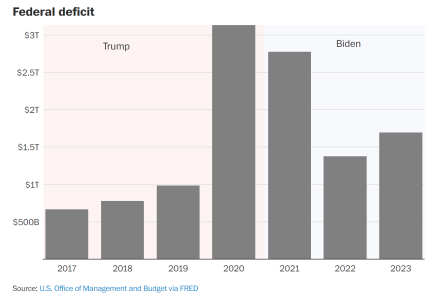Wait, you don't think printing all of that money for social give aways and reckless spending was responsible for the 500% growth of inflation after Biden took office? Even Jimmy Carters' legendary inflation rise was only 200%. President Biden has set records in spending and debt in a Presidents first 20 months in office. Bidens democrats have increased spending by $10 trillion more than projected when Biden took office.
Oh, you don't think the US had been "printing money" since LONG before Biden was President?
Biden’s economy vs. Trump’s, in 12 charts
The presidential election is less than a year away, and economic issues are once again top of mind for voters around the country.
Despite the economy’s rapid recovery from the pandemic,
President Biden has struggled to convince Americans that his policies are improving their finances. In polls, the majority of Americans still say they trust former president Donald Trump’s handling of the economy over Biden’s.
Both presidents’ economic records have been defined by the pandemic and its aftershocks. The covid crisis upended the job market, stoked decades-high inflation and added trillions of dollars to the federal debt.
The economy today is vastly different from it was in 2017, when Trump took office. But the data shows just how each administration has left its mark: Biden, by adding 14 million jobs in less than three years, bringing the Black unemployment rate to a record low and reducing student loan debt by billions. Trump, meanwhile, presided over a period of low inflation, low interest rates and low
gas prices.
Here are 12 charts showing the state of the economy now vs. under Trump.
1. Job gains
The astoundingly strong labor market is arguably the White House’s biggest victory. In some ways, the bump was inevitable — Biden took office at a time when millions were still out of work because of the pandemic. Even so, the rapid job gains in recent years have blown past economists’ expectations and have fueled the economy’s blockbuster growth.
Even more remarkable is that the labor market has remained strong, despite the Federal Reserve’s aggressive efforts to slow the economy. As long as Americans are employed, they’ve been able to withstand inflation and keep spending, allowing the economy to grow.
Employers have created
14 million jobs during the Biden administration, with a monthly average of more than 400,000 positions. Recently, though, the pace of job creation has slowed, with
199,000 new jobs in November.
By contrast, the economy added an average 176,000 jobs a month during Trump’s first three years, before coronavirus-related closures and layoffs resulted in the sudden loss of more than 20 million jobs.
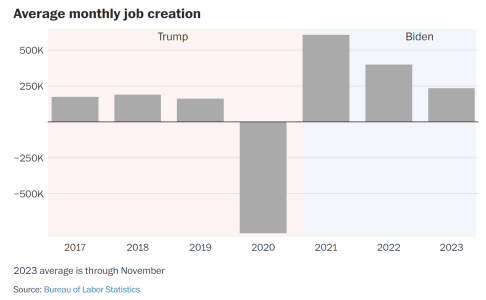
2. Unemployment rate
Aside from a covid-fueled surge in much of 2020 and 2021, the national unemployment rate has remained low through both Trump’s and Biden’s presidencies.
Joblessness fell during the Trump years to a half-century low of 3.5 percent in early 2020, just before the pandemic. During Biden’s presidency, the unemployment rate has inched down even further, to 3.4 percent earlier this year. It now stands at
3.7 percent.
The years-long pickup in hiring has been particularly good for workers who are typically underrepresented in the labor force. Unemployment rates for Hispanic workers,
Black women and people with disabilities have all hit record lows under Biden’s watch.
The Black unemployment rate, which Trump liked to take credit for improving during his presidency, fell during both administrations, but reached an all-time low during the Biden era earlier this year.
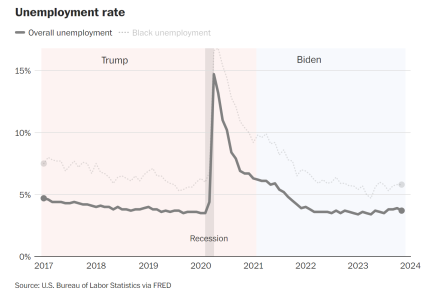
3. Economic growth
For the most part, the U.S. economy has expanded at a steady pace under both Trump and Biden. Gross domestic product, a measure of all of the goods and services produced in the country, has grown about 22 percent since Biden took office. That’s compared with a 14 percent uptick during Trump’s presidency, when the pandemic forced the economy into a steep and sudden recession. Even so, the economy rebounded quickly — thanks in part to trillions in stimulus money — and was growing again by the time Trump left office.
Now, under Biden, the economy has notched five straight quarters of growth following a six-month slump last year. The latest expansion has been powered by heavy consumer spending, which makes up about 70 percent of the economy, and new infrastructure and green-energy projects spearheaded by the Biden administration. But economists note that the current rate of economic growth — an annualized rate of 4.9 percent, as of September — is unsustainable, and many expect growth to cool next year.
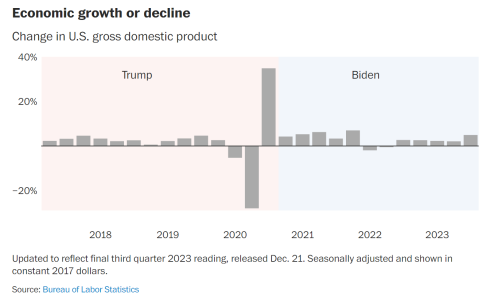
4. Gas prices
Presidents have very little control over gas prices. But this is one area where the Trump era was better for Americans — and could help explain some of the gloom Americans are feeling now.
Pandemic-related hiccups, the war in Ukraine and spikes in demand have all sent gas prices on a dizzying roller-coaster ride since 2020. Gas prices more than doubled between April 2020 and April 2022, from $1.84 a gallon to $4.11. They peaked at an all-time high of nearly $5 a gallon in June 2022 but have come down since. Analysts say prices gas prices could fall below $3 per gallon by the end of the year, thanks to a combination of increased production and slowing demand.
Gas prices have a direct effect on how Americans view the economy, and higher prices at the pump have translated to lingering pessimism for much of Biden’s presidency.
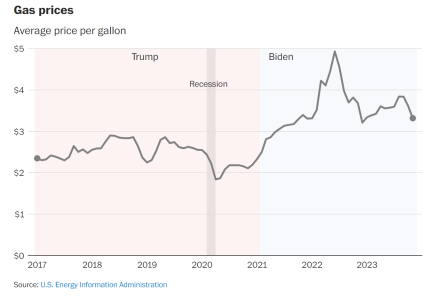
5. Home prices
Homeownership is one of the biggest ways Americans create wealth, and the recent run-up in prices has been a double-edged sword: Many first-time home buyers been shut out of the market, but people who already own homes have benefited from soaring property values.
On the whole, though, homeownership has become far less accessible during the Biden administration. Home prices have surged during the pandemic, rising an eye-popping 49 percent between spring 2020 and fall 2022. Those higher costs have driven housing affordability to all-time lows, according to Goldman Sachs. Homes are currently selling for a median price of $431,000 — less than the $480,000 they were commanding last year, but still well over pre-pandemic norms.
Mortgage rates have more than doubled in the past two years — from about 3.1 percent to about 7 percent — making it that much pricier to purchase a home and putting a chill on the market. Prices, though, remain high because demand for homes continues to outpace supply.
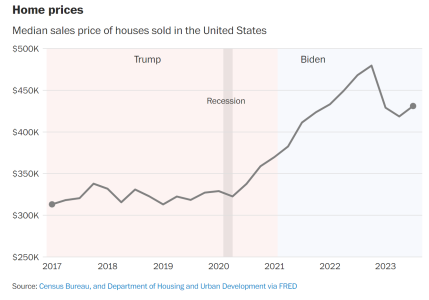
6. Inflation
Inflation has been a persistent challenge for the Biden administration. A rapid run-up in prices after the pandemic resulted in the highest inflation in more than 40 years. Americans have been pinched by higher costs for just about everything, including groceries, gas, cars and health care.
Although inflation has recently come down from last summer’s peaks, prices are still about 3 percent higher than they were a year ago. Many Americans say higher costs have tainted their views of the economy, with voters consistently citing inflation as their top economic concern.
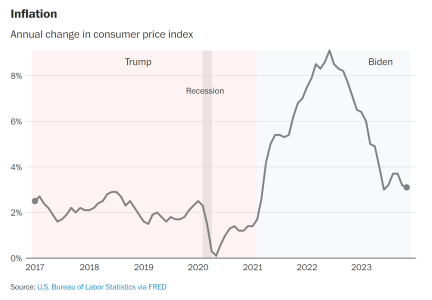
7. Interest rates
The president has very little power over interest rates. While the Federal Reserve’s chair and governors are appointed by the president and confirmed by Congress, the central bank operates independently.
But the Fed’s actions have a far-reaching impact on the economy. During Biden’s presidency, the central bank has raised interest rates 11 times as part of its effort to rein in inflation. The bank controls the federal funds target range — the interest rate banks use to lend money to each other overnight — which, at 5.25 to 5.5 percent, is at its highest level in 22 years.
Each time the Fed raises that rate, or even hints that it might, there are ripple effects across the economy, resulting in higher borrowing costs for loans of all types, including mortgages (currently at
about 7 percent), personal loans (
12 percent, according to Bankrate) and credit cards (
above 20 percent).
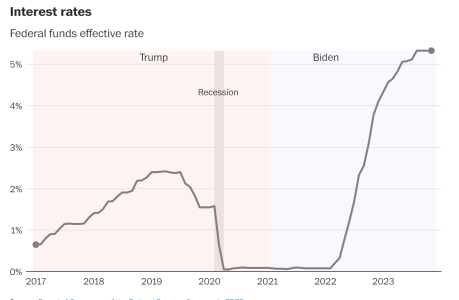
8. Disposable income
Americans have less spending power than they did at the beginning of Biden’s term. A drop-off in stimulus money, plus rising prices, have caused large swings in household income since 2020. Still, many Americans are ending 2023 better off than they were a year ago, as wage gains outpace inflation.
During the Trump years, by comparison, Americans saw a steady increase in spending power until the start of the pandemic. Overall, real disposable income, or what Americans are left with after taxes and inflation, rose about 10 percent between January 2017 and January 2020.
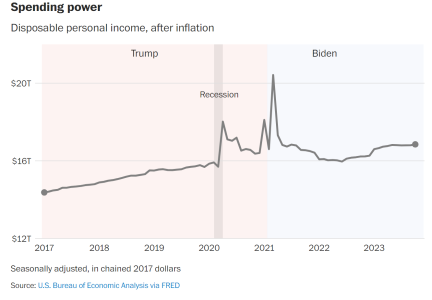
9. Stock market
The stock market rose rapidly during Trump’s presidency and has continued its ascent under Biden. After a period of slowing last year — in anticipation of higher borrowing costs and increased volatility — stock prices have picked back up on optimism that the Fed is done raising interest rates. The Dow Jones Industrial Average and the Nasdaq hit all-time highs this month, and the Standard & Poor’s 500 is on track to follow suit.
Trump kept a close eye on the stock market’s path during his presidency, often taking to social media to flaunt his successes. He also warned Americans that a Biden presidency would result in a “stock market collapse the likes of which you’ve never had.”
That has not happened — which the president was quick to note. “
Good one, Donald,” Biden recently fired back on X.
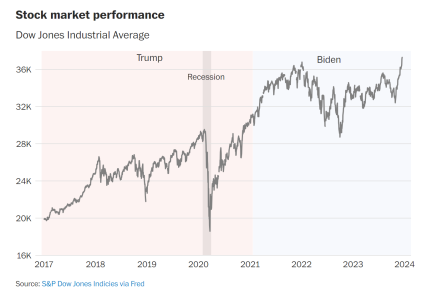
10. Student loan debt
Outstanding student loan balances have been climbing for nearly two decades — until now.
Biden took office vowing to whittle down the debt burden on student and graduates. And while his most ambitious plans, including a $400 billion forgiveness plan, have been blocked by
Republican lawmakers and
the Supreme Court, his administration has found ways to offer relief.
To date, the White House has canceled some $132 billion in student loan debt for more than 3.6 million Americans. It has also increased federal Pell Grants to low- and middle-income students, allowing them to take on less debt. As a result, outstanding student loan balances have been falling for six months. Americans owed $1.74 trillion in student loans in October, down from a record $1.77 trillion at the beginning of the year.
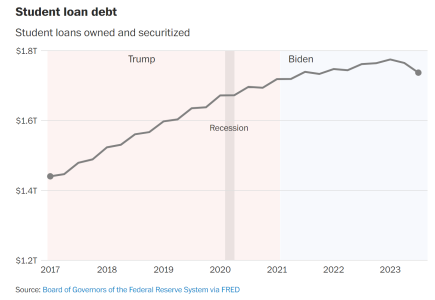

 www.threads.net
www.threads.net












